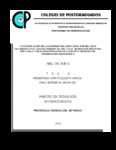| dc.contributor.author | Val Noris, Abel | |
| dc.date.accessioned | 2013-09-11T20:11:06Z | |
| dc.date.available | 2013-09-11T20:11:06Z | |
| dc.date.issued | 2013 | |
| dc.identifier.uri | http://hdl.handle.net/10521/2041 | |
| dc.description | Tesis (Maestría Tecnológica, especialista en Hidrociencias).- Colegio de Postgraduados, 2013. | en_US |
| dc.description.abstract | Las heladas son un fenómeno natural que se presenta en la mayor parte de la Tierra. En el norte y centro de la República Mexicana, durante los meses fríos del año, se presentan temperaturas menores de 0°C. Las regiones más afectadas están localizadas principalmente en la Mesa Centro-Norte del Altiplano y en la Sierra Madre Occidental, principalmente. Las imágenes de satélite y los sistemas de información geográfica (SIG) son herramientas que nos permiten manejar en forma conjunta la información geográficamente referenciada e información de cada conjunto de vectores e imágenes y nos auxilian para la detección y cuantificación de superficie afectada por dicho fenómenos meteorológico para representar los resultados en mapas de alta calidad.
En este estudio se evaluó la afectación por heladas ocurridas los días del 3 al 6 de febrero del 2011, en los cultivos de maíz de otoño y el trigo de invierno en el área del Distrito de Riego 041 Rio Yaqui, Sonora, México, Mediante imágenes de satélite, procesadas en el IDRISI andes para determinar los NDVI, del antes y después de haber ocurrido el evento y posteriormente la aplicación de los sistemas de información geográfica para su cuantificación. Se utilizaron 2 imágenes satelitales del día 16 de enero antes y 14 de febrero del 2011 después del evento y con estas imágenes se calcularon los NDVI de las parcelas establecidas y las diferencias del NDVI, se clasificaron en cinco grados de acuerdo a su afectación con los siguientes resultados. De las 8,089 hectáreas con las superficie que contaba el modulo de riego al momento de la helada 701.38 hectáreas de maíz fueron desbastadas y sin afectación 7,388.36 hectáreas. La información muestra que también los daños por frío intenso en esta etapa son importantes al igual que los daños que ocasionan las altas temperaturas al amacollamiento, reportado e informado con antelación a los productores de maíz y trigo en esta región y que fue validado con los resultados comerciales al final de la cosecha, Se calculo la probabilidad de ocurrencia sobre heladas utilizando 40 años de datos históricos de temperaturas mínimas en la estación de Batevito, encontrándose que la probabilidad de que se presente una helada por debajo de los – 2° C, es 1 en 100 años.
_______________ QUANTIFICATION OF THE AREAS AFFECTED BY FROSTS IN FEBRUARY 2011, IN THE IRRIGATION DISTRICT 041, YAQUI RIVER USING SATELLITE IMAGES AND GEOGRAPHIC INFORMATION SYSTEMS. ABSTRACT:
Frosts are natural phenomena that occur in the major part of the earth. Temperatures below cero Celsius degrees take place in the north and central part of Mexico, during the cold months of the year. The regions more affected by these events are located mainly in la Sierra Madre Occidental. Satellite images and the Geographical Information Systems (GIS) are valuable tools that let to implement methodologies to detect and quantify affected surfaces by this meteorological phenomenon. GIS systems permit to generate maps and digital products that permit to highlight the areas more affected to implement actions to mitigate the impacts made. In this study, an evaluation of the affected surface by the frost event that occurred from February 3 to 6 during 2011 was made. Affected surface was mainly planted with corn and wheat in the Irrigation District 041 Rio Yaqui, Sonora, Mexico. Satellite Images were processed to estimate the vegetation index NDVI before and after the frost date. IDRISI software was used to process the images and ArcView was used to quantify the impacted areas. Two Rapid Eye satellite images for the dates of January 16 and February 14 were used. The hypothesis was that the plots affected by the frost will present a reduction in the NDVI. Plots affected by the frost were classified in five categories or affectation levels. As a particular case of this analysis, a section of the Irrigation District was analyzed. It was found that 701.38 ha of this section were very affected by the frost events. Cold damages to the plants caused reductions in the yields. Also a probability analysis of this event was made, using 40 years of minimum temperature for the climatological station Batevito, it was found that the probability of the occurrence of this event is 1 in 100 years using a critical temperature of – 2° C. | en_US |
| dc.language.iso | spa | en_US |
| dc.subject | Hidrociencias | en_US |
| dc.subject | Maestría Tecnológica | en_US |
| dc.title | Cuantificación de las superficies afectadas por heladas ocurridas en el mes de febrero de 2011, en el distrito de riego 041, Río Yaqui, utilizando imágenes de satélite y sistemas de información geográfica | en_US |
| dc.type | Tesis | en_US |
| Tesis.contributor.advisor | Chávez Morales, Jesús | |
| Tesis.contributor.advisor | Salgado Tránsito, Jorge Arturo | |
| Tesis.contributor.advisor | Flores Magdaleno, Héctor | |
| Tesis.date.submitted | 2013 | |
| Tesis.date.accesioned | 2013-08-28 | |
| Tesis.date.available | 2013-09-11 | |
| Tesis.format.mimetype | pdf | en_US |
| Tesis.format.extent | 4,314 KB | en_US |
| Tesis.subject.nal | Daño por heladas | en_US |
| Tesis.subject.nal | Frost injury | en_US |
| Tesis.subject.nal | Sistemas de Información Geográfica | en_US |
| Tesis.subject.nal | Geographic Information Systems | en_US |
| Tesis.subject.nal | Teledetección | en_US |
| Tesis.subject.nal | Remote sensing | en_US |
| Tesis.subject.nal | Sonora, México | en_US |
| Tesis.rights | Acceso abierto | en_US |
| Articulos.subject.classification | Sistemas de información | en_US |

